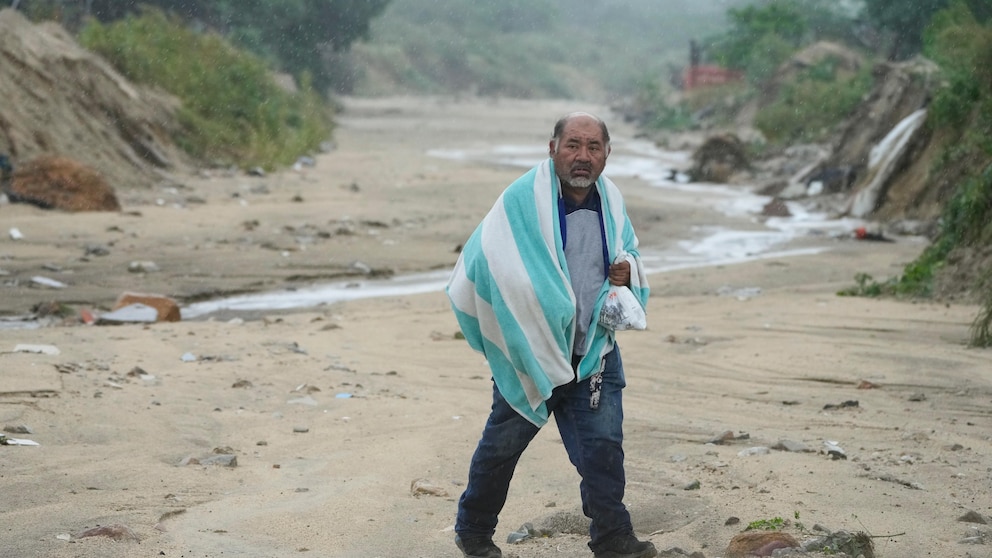
CABO SAN LUCAS, Mexico — Norma was downgraded to a tropical storm Sunday as it moved into mainland Mexico, while Hurricane Tammy left the Caribbean island of Barbuda with minor damage.
Once a Category 4 hurricane, Norma came ashore Saturday as a Category 1 hurricane near the Pacific resort of Los Cabos at the southern tip of Mexico’s Baja California Peninsula. Tammy made landfall hours later at the same strength.
Norma's winds, although weakened, continue to cause damage as the storm moves northeast, crossing the Gulf of California toward the Mexico mainland in the Sinaloa state. Authorities in Baja California are evaluating what the storm wrought in the southern part of the state. At least 70,000 people were reported without electricity.
T he U.S. National Hurricane Center in Miami said in its latest report that Norma was about 120 miles (195 kilometers) west of Culiacan, and about 65 miles (105 kilometers) south-southwest of Los Mochis. The storm is moving northeastward across the Gulf of California with maximum sustained winds of 60 mph (95 kmp).
The NHC expects that heavy rains from Norma will continue impacting Sinaloa at least until Monday, and also some parts of the southern area of Baja California. It warned of flooding and mudslides.
The area is vulnerable to rain because it is a dry region generally, said John Cangialosi, a senior specialist at the National Hurricane Center.
“Six to 12 inches of rain is what is generally forecast, but there could be pockets of up to 18 inches of rain and we do think that will be the most significant impact that could result in flash and urban flooding and mudslides,” he said.
In Cabo San Lucas, where businesses nailed plywood over their windows, curious tourists began to pick their way along debris-strewn beaches after the storm passed.
Authorities urged people to stay at home Saturday night. There were still families in shelters in Cabo San Lucas and San Jose del Cabo, though officials did not say how many. Around 200 people were in shelters in La Paz.
Baja California Sur Gov. Victor Castro said on X that “because it’s moving slowly, greater damages are anticipated.” But little damage was initially reported. Some trees and power poles were down, but there were no reports of injuries.
Police in San Jose del Cabo rescued two people from their truck when a surging stream swept it away early Saturday. Some informal settlements, away from the hotels that serve tourists, were isolated by rising water. Some neighborhoods lost electricity and internet service.
The federal government posted 500 marines to the resort area to help with storm preparations.
By late morning, the area’s streets were littered with palm fronds and other debris, and essentially deserted except for occasional military patrols. Strong winds whipped traffic signs, trees and power lines.
Hotels in Los Cabos, which are largely frequented by foreign tourists, remained about three-quarters full and visitors made no major moves to leave en masse, officials said. The local hotel association estimated about 30,000 tourists were in Cabo San Lucas and San Jose del Cabo on Friday.
Airports were closed but San Jose del Cabo airport director Francisco Villaseñor said he expected flights to resume by midday Sunday.
Meanwhile, Antigua and Barbuda escaped with no reported injuries from Hurricane Tammy. A late and sudden shift spared the mainland from a direct hit, but left the sister island in line for the system’s full force during the late night hours on Saturday.
“To the best of my knowledge, there has been no significant damage. At least we got some rain. It may not be a lot but much needed rain,” a relieved Prime Minister Gaston Browne told The Associated Press.
The hurricane made landfall on the 62-square-mile island at approximately 9:15 p.m. on Saturday, bringing heavy rain and winds as high as 92 mph. The storm knocked down some power lines, triggered an island wide blackout and caused minor damage to a few homes. However, no major infrastructural damage was reported.
At least two families had to be evacuated by a local rescue team, Barbuda’s disaster coordinator Tessa Webber told The Associated Press.
Tammy hit as the memory and trauma of Hurricane Irma, a Category 5 storm that razed the island in 2017, remained foremost in the minds of Barbudans.
Mainland Antigua fared much better, as only a few broken branches and broken utility lines were reported.
Acting electricity manager for the country’s lone utility company, Lyndon Francis, could not yet put a timeline on restoration work in Barbuda and the few communities in Antigua that lost power during the storm. Crews were out assessing the damage, he said.
Government offices, banks and most non-retail businesses had closed early on Friday to allow staff to prepare. Residents rushed to stock up on necessities, causing gridlock throughout St John’s and near popular shopping centers and supermarkets.
___
Associated Press writer Anika Kentish in St. John's, Antigua, contributed to this report.
___
Follow AP’s climate coverage at: https://apnews.com/hub/climate-and-environment
Sourse: abcnews.go.com






